Patuxent Research Refuge & National Wildlife Visitors Center
By Joseph Patrick Bulko
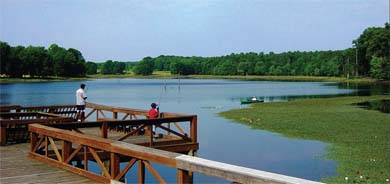
Nestled amidst the encroaching sprawl of suburbia, as Baltimore and Washington, DC gradually blend into one contiguous metropolitan region, strangling residents with a phalanx of congested roadways, lies an oasis of wilderness, a densely forested realm teaming with wildlife – and scientific research.
In the wooded sanctuary, where deer and whooping cranes play, biologists mingle with visitors, the former studying the impact of humanity on the natural world and the latter temporarily escaping the pressures of modern life by hiking, fishing, and hunting in woods resplendent with natural gifts.
“The refuge is 12,790 acres,” said Nell Baldacchino, Patuxent’s Visitor Services Manager. “It’s this little island of green right in the middle of a very rapidly developing Baltimore-Washington corridor. One of our senators has called it the lungs of the corridor. It’s fantastic to have this open space right near these two big urban areas.”
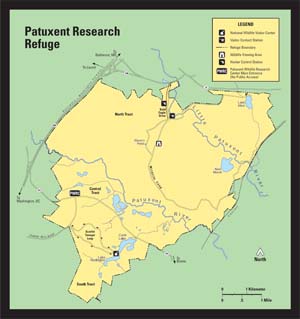 Only a short drive from Annapolis, just north of Bowie, the wildlife retreat is tucked into a swatch formed by the B-W Parkway and Routes 32, 198, and 197, surrounding the Patuxent and Little Patuxent Rivers. Only a short drive from Annapolis, just north of Bowie, the wildlife retreat is tucked into a swatch formed by the B-W Parkway and Routes 32, 198, and 197, surrounding the Patuxent and Little Patuxent Rivers.
“The Patuxent Research Refuge has actually been here since 1936,” when it was created by an executive order of President Franklin D. Roosevelt, Baldacchino explained. “It’s the only refuge that was established for research.”
Patuxent is one of over 500 refuges in the National Wildlife Refuge System administered by the US Fish and Wildlife Service. The refuge system is a network of lands and waters managed specifically for the protection of wildlife and wildlife habitat, and it represents the most comprehensive wildlife management program in the world.
Having grown from the original 2670 acres, it encompasses land formerly managed by the Departments of Agriculture and Defense. Throughout decades of change, Patuxent’s mission of conserving and protecting the nation’s wildlife and habitat, through research and wildlife management techniques, has remained virtually unchanged.
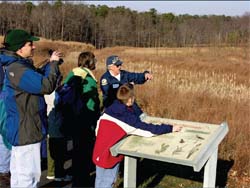 Patuxent Research Refuge is divided into three areas: North Tract, which offers hunting, fishing, wildlife observation, trails, and many interpretive programs, Central Tract, where the offices and study sites of the many research biologists are located, and South Tract, where the National Wildlife Visitor Center and its trails are located. The Visitor Center and North Tract are the only areas open for visitor activities. Patuxent Research Refuge is divided into three areas: North Tract, which offers hunting, fishing, wildlife observation, trails, and many interpretive programs, Central Tract, where the offices and study sites of the many research biologists are located, and South Tract, where the National Wildlife Visitor Center and its trails are located. The Visitor Center and North Tract are the only areas open for visitor activities.
“The National Wildlife Visitors Center is indeed
a national visitors center,” Baldacchino said. In addition to telling about wildlife on the Patuxent refuge, “this visitor center tells about wildlife research all over the country, and even internationally.”
Located off Powder Mill Road in Laurel, the Visitor Center is one of the largest science and environmental education centers operated by the US Department of the Interior. The unique facility seeks to impart to young and old alike an increased knowledge of, and appreciation for, the earth’s vital resources. It features interactive exhibits that focus on global environmental issues, migratory bird studies, habitats, endangered species, and the tools and techniques used by scientists.
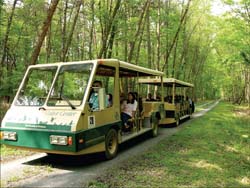 “It’s a great place for school teachers to come with their classes,” Baldacchino enthused. “Teachers usually come to the workshop ahead of time. We have lots of school kids. We try to tie curricula to the exhibits. We have senior citizen bus tour groups. It’s for everybody. We have a lot of families on the weekends stopping by. When the weather’s bad, we have lots of indoor exhibits.” “It’s a great place for school teachers to come with their classes,” Baldacchino enthused. “Teachers usually come to the workshop ahead of time. We have lots of school kids. We try to tie curricula to the exhibits. We have senior citizen bus tour groups. It’s for everybody. We have a lot of families on the weekends stopping by. When the weather’s bad, we have lots of indoor exhibits.”
The Visitor Center also offers hiking trails, tram tours, a seasonal fishing program, wildlife management demonstration areas, and an outdoor education site for school classes. A large auditorium and meeting rooms can accommodate scientific conferences, meetings, teacher workshops, lectures, and traveling displays.
Tram tours run every weekend, spring through fall, weather permitting, and weekdays during the summer. “People can explore the habitats on an all-electric quiet vehicle, and learn about wildlife management,” Baldacchino continued. “It’s a great way to explore the habitats, especially for people who can’t get out to do a lot of hiking. It goes through areas that are closed to the public, on a narrow winding little road. They get to see samples of the wetlands, the forest, and the meadow habitats, and how we manage them for wildlife.”
Patuxent Research Refuge supports a wide diversity of wildlife, and the land is managed to maintain biological diversity for the protection and benefit of native and migratory species. During the fall and spring migrations, many waterfowl species stop to rest and feed. There are over 200 species of birds on the refuge, one of the largest forested areas in the mid-Atlantic region. It provides critical breeding habitat and an important nesting area for neotropical migratory birds.
 For those folks interested in helping care for the environment, Baldacchino suggests “simple things like picking up litter, planting wildlife shrubs in their backyard, recycling – and volunteering. We have lots of wonderful volunteers here. We could not operate this facility, particularly in this time of challenging federal budgets, without our volunteer help.” For those folks interested in helping care for the environment, Baldacchino suggests “simple things like picking up litter, planting wildlife shrubs in their backyard, recycling – and volunteering. We have lots of wonderful volunteers here. We could not operate this facility, particularly in this time of challenging federal budgets, without our volunteer help.”
The US Geological Survey operates the Patuxent Wildlife Research Center, located on the refuge’s Central Tract, an area closed to the public. “That’s where they raise the whooping cranes,” Baldacchino said. “That’s where they do a lot of work with environmental contaminants. The bird-banding lab, monitoring birds all over the country, is located there.”
Biologist Sam Droege, a friendly researcher who bears a striking resemblance to Tour de France cyclist Floyd Landis in appearance and demeanor, is the Research Center’s bee guy. “My job is to figure out how to count things,” he said. “Right now I’m figuring out how to count bees. My objective is figuring out how many there are, whether there are more of them or fewer of them.”
The possible bee decline has become a subject of intense scrutiny only in the past 10 years. The prime culprit seems to be human-created pesticides, which kill friendly bees during the process of crop protection. “In general, it’s manmade causes,” said the Landis-clone scientist. “So far we think three species have gone extinct in North America. Two of the species were the most common bees in their areas.”
Why study bees? Why is the bee important? Pollination. “No bees, no fruit. No bees, no nuts. No bees, no squash,” he explained. “They’re not only pollinating our crops, but our native plants, too. They’re a pretty fundamental subcomponent of the environment.”
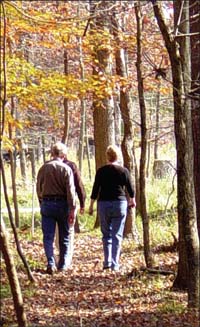 Bees have never been studied thoroughly before, he continued. “Except for a few very uncommon exceptions, we have no idea what the status of bees is. We don’t even know what bees are out there. We can’t tell you if they’re increasing or decreasing. The perception, though, is that they’ve declined. That’s why we’re doing bees.” Bees have never been studied thoroughly before, he continued. “Except for a few very uncommon exceptions, we have no idea what the status of bees is. We don’t even know what bees are out there. We can’t tell you if they’re increasing or decreasing. The perception, though, is that they’ve declined. That’s why we’re doing bees.”
Another researcher is focused on turtles. “We are studying the population ecology of diamondback terrapins,” said Mike Haramis, wildlife biologist, “looking at mortality factors and the demography of the species and how abundant they are in the Bay and where. It all involves a perceived decline of terrapins in the upper Bay, especially where we’ve developed the shoreline so much, and they’ve lost the nesting habitats, and we have all these man-related risks such as boat strikes that are killing terrapins.“
Turtle soup, which hasn’t been part of the American menu since World War II, remains a prime use of the terrapin. “The fear is that these ethnic markets, pet markets, and other uses of the turtle are growing,” he noted. The good news is that “they are not threatened or endangered. There is an abundance of terrapins in the lower Bay.”
The North Tract of Patuxent Research Refuge includes 8100 acres that were formerly a military training area. It is open daily, with the exception of Thanksgiving, Christmas, and New Year’s Day. Hunting is permitted only during established Maryland hunting seasons, and visitors can fish in the region’s many lakes, ponds, and rivers.
Approximately 20 miles of roads and trails exist for hiking, bicycling, and horseback riding. There is a wetland and wildlife viewing area where visitors can observe waterfowl, shorebirds, raptors, and songbirds in an area that was formerly an artillery testing range. Staff and volunteers at North Tract offer guided bird and nature walks as well as environmental education programs throughout the year.
“We have trails people hike,” Baldacchino said. “We have tons of people who come out just to escape from their normal lives, from the pavement and rat race of typical life, and they love getting out on the trails. We get a lot of people who just want to come and relax and get away from the hectic pace. It’s a great place for that.”
Back
|

